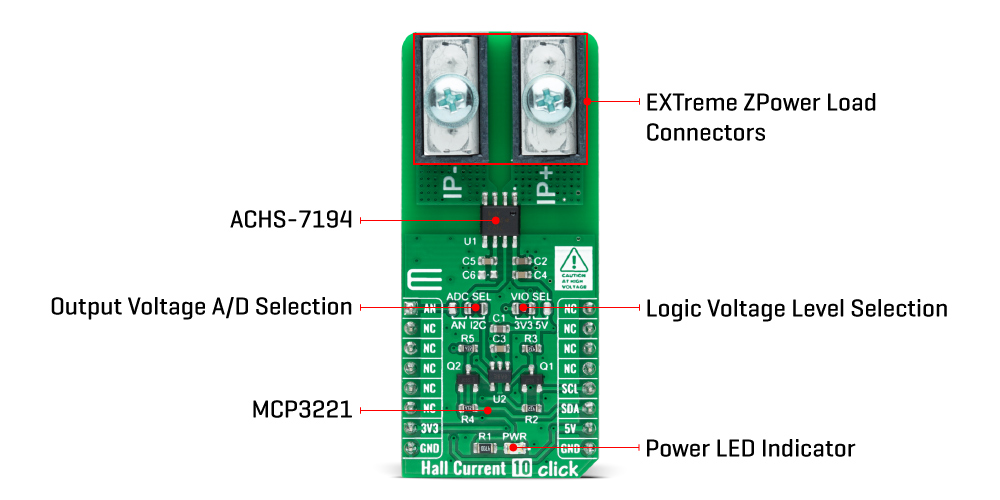OFF
GO LOCAL
| Company | Stock | Price |
|---|---|---|

MIKROE-4587
28 g
Status:
Hall Current 10 Click is a compact add-on board that provides economical and precise AC or DC current sensing solutions. This board features the ACHS-7194, a fully integrated Hall-effect-based isolated linear current sensor designed for the current range of ±40A from Broadcom Limited. Inside ACHS-7194 is a precise, low-offset, linear Hall circuit with a copper conduction path located near the surface of the die. Applied current flowing through this copper conduction path generates a magnetic field that the differential Hall sensors convert into a proportional voltage, where after that, the user is given the option to process the output voltage as an analog or digital value. This Click board™ is suitable for AC or DC current-sensing in industrial, commercial, and communications systems.
Hall Current 10 Click is supported by a mikroSDK compliant library, which includes functions that simplify software development. This Click board™ comes as a fully tested product, ready to be used on a system equipped with the mikroBUS™ socket.
This product is no longer in stock
Availability date:
OFF
| Company | Stock | Price |
|---|---|---|

 DO NOT TOUCH THE BOARD WHILE THE EXTERNAL POWER SUPPLY IS ON!
DO NOT TOUCH THE BOARD WHILE THE EXTERNAL POWER SUPPLY IS ON!
Note: This Click board™ needs to be used by trained personnel only while applying high voltages. Special care should be taken when working with hazardous voltage levels.
Hall Current 10 Click as its foundation uses the ACHS-7194, a Hall-effect current sensor that sends an analog voltage proportional to the magnetic field intensity caused by the current flowing through the primary input conductor from Broadcom Limited. Without a magnetic field, the output voltage is half of the supply voltage. The ACHS-7194 can detect both DC and AC designed for the current range of ±40A. Device accuracy is optimized across the operating ambient temperature through the close proximity of the magnetic signal to the Hall sensors.

The thickness of the copper conductor allows the survival of the device at high overcurrent conditions. The terminals of the conductive path are electrically isolated from the signal leads. This feature enables the ACHS-7194 to be used in applications requiring electrical isolation without optoisolators or other costly isolation techniques.
The ACHS-7194 also has a ratiometric output that means it changes proportionally to the supply voltage. Just like that, the output voltage, analog signal, can be converted to a digital value using MCP3221, a successive approximation A/D converter with a 12-bit resolution from Microchip, using a 2-wire I2C compatible interface, or can be sent directly to an analog pin of the mikroBUS™ socket labeled as AN. Selection can be performed by onboard SMD jumper labeled as ADC SEL to an appropriate position marked as AN and I2C.
With the MCP3221, data transfers at rates of up to 100kbit/s in the Standard and up to 400kbit/s in the Fast Mode. Also, maximum sample rates of 22.3kSPS with the MCP3221 are possible in a Continuous-Conversion Mode with a clock rate of 400kHz.
This Click board™ can operate with both 3.3V and 5V logic voltage levels selected via the VIO SEL jumper. This way, it allows both 3.3V and 5V capable MCUs to use the communication lines properly. However, the Click board™ comes equipped with a library containing easy-to-use functions and an example code that can be used, as a reference, for further development.
Type
Current sensor,Measurements
Applications
Can be used for AC or DC current-sensing in industrial, commercial, and communications systems
On-board modules
ACHS-7194 - fully integrated Hall-effect-based isolated linear current sensor designed for the current range of ±40A from Broadcom Limited
Key Features
Output voltage proportional to AC or DC currents, ratiometric output from supply voltage, high reliability, factory-trimmed for accuracy, stable output offset voltage, isolation voltage (3kVrms / 1 minute), and more
Interface
Analog,I2C
Feature
No ClickID
Compatibility
mikroBUS™
Click board size
L (57.15 x 25.4 mm)
Input Voltage
3.3V or 5V
This table shows how the pinout on Hall Current 10 Click corresponds to the pinout on the mikroBUS™ socket (the latter shown in the two middle columns).
| Label | Name | Default | Description |
|---|---|---|---|
| LD1 | PWR | - | Power LED Indicator |
| JP1 | VIO SEL | Left | Logic Level Voltage Selection 3V3/5V: Left position 3V3, Right position 5V |
| JP2 | ADC SEL | Right | Output Voltage A/D Selection AN/ADC: Left position AN, Right position ADC |
| Description | Min | Typ | Max | Unit |
|---|---|---|---|---|
| Supply Voltage | 3.3 | - | 5 | V |
| Input Current Range | -40 | - | +40 | A |
| Sensitivity | - | 50 | - | mV/A |
| Operating Temperature Range | -40 | +25 | +110 | °C |
We provide a library for the Hall Current 10 Click as well as a demo application (example), developed using MikroElektronika compilers. The demo can run on all the main MikroElektronika development boards.
Package can be downloaded/installed directly from NECTO Studio Package Manager(recommended way), downloaded from our LibStock™ or found on Mikroe github account.
Library Description
This library contains API for Hall Current 10 Click driver.
Key functions:
hallcurrent10_cfg_setup - Config Object Initialization function.hallcurrent10_init - Initialization function.hallcurrent10_default_cfg - Click Default Configuration function.Examples description
This library contains API for Hall Current 10 Click driver. The demo application reads ADC value, ADC voltage and current value.
The demo application is composed of two sections :
void application_task ( void )
{
hallcurrent10_read_adc( &hallcurrent10, &adc_data );
log_printf( &logger, " ADC Value : %d rn", adc_data );
Delay_ms( 100 );
hallcurrent10_get_adc_volatge( &hallcurrent10, &adc_voltage );
log_printf( &logger, " ADC Voltage : %.2f mV rn", adc_voltage );
log_printf( &logger, "- - - - - - - - - - - - -rn" );
Delay_ms( 100 );
hallcurrent10_get_current ( &hallcurrent10, ¤t );
log_printf( &logger, " Current : %.2f mA rn", current );
log_printf( &logger, "--------------------------rn" );
Delay_ms( 2000 );
}
The full application code, and ready to use projects can be installed directly from NECTO Studio Package Manager(recommended way), downloaded from our LibStock™ or found on Mikroe github account.
Other Mikroe Libraries used in the example:
Additional notes and informations
Depending on the development board you are using, you may need USB UART click, USB UART 2 click or RS232 click to connect to your PC, for development systems with no UART to USB interface available on the board. The terminal available in all MikroElektronika compilers, or any other terminal application of your choice, can be used to read the message.
This Click board™ is supported with mikroSDK - MikroElektronika Software Development Kit. To ensure proper operation of mikroSDK compliant Click board™ demo applications, mikroSDK should be downloaded from the LibStock and installed for the compiler you are using.
For more information about mikroSDK, visit the official page.
NOTE: Please be advised that any peripheral devices or accessories shown connected to the Click board™ are not included in the package. Check their availability in our shop or in the YMAN section below.